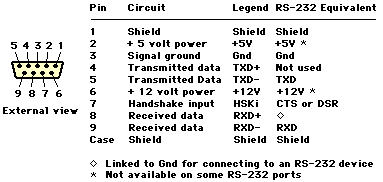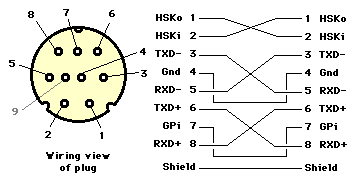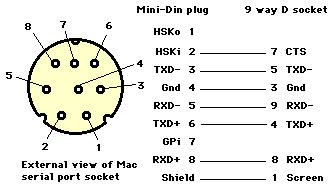
Older computers often have simple serial ports instead of USB or FireWire connections. These only accommodate one device at a time, although you can use a serial port switch box to choose one of several devices.
Most ‘classic’ Mac OS models have two such ports, usually designated as Modem and Printer ports, as well as Apple Desktop Bus (ADB) connections. All of these convey data in serial form, with each bit of data transported in turn along a common circuit, which makes them rather slow, although they employ convenient low-cost connectors and lightweight cables.
The Modem and Printer ports are based on the RS-422 standard, with data sent in asynchronous form, consisting of a start bit, followed by eight data bits and a stop bit. These short bursts minimise timing problems, avoiding the need for a separate clock circuit. Hence the data can be eventually sent over a two-wire circuit, such as a telephone line connected via a modem.
To ensure data is sent reliably over a link, some form of handshaking is normally used. Software handshaking, operated by special control codes sent between the devices, is effective, but slows down the interface. Hardware handshaking, as employed, for example, between a modem and a computer, is faster but requires additional wires in the cable.
Unlike the standard serial ports, the ADB interface on older Mac OS machines is synchronous. Hence it includes an extra wire that conveys a clock circuit, which provides a timing reference for the receiving device.
A Modem or Printer port can provide a point-to-point connection, such as linking a printer to a computer, as shown below:-

To use several devices you must fit a manually-operated serial port switch box or serial port expander, the latter using software to fool the computer into seeing only one device at a time. The box or port expander is connected as shown here:-

The ADB interface is different in that it acts as a bus, allowing several devices, such as a keyboard, mouse or modem to be connected at once. Connections can be made using a daisy chain, as shown below:-

 Modem and Printer Ports
Modem and Printer PortsAlthough the Modem and Printer ports are essentially standard RS-422 interfaces, they can also be wired for compatibility with RS-232, allowing them to operate with almost any serial device. The ports appear on an 8-way mini-DIN socket or 9-way mini-DIN socket, although very early Macs are fitted with a 9-way miniature D socket, also known as a DB9 connector. Unfortunately, the wiring of these connectors is entirely different to those found on non-Macintosh equipment.
These ports default to a rate of 9.6 kbit/s, which is fast enough for most printers, although they can run at up to 57.6 kbit/s or higher. With some computers, an external clock can be applied to the General Purpose input (GPi) pin, allowing speeds of 115.2, 230.4, 460.8 or even 921.6 kbit/s. When used for a LocalTalk network, the ports run at 230.4 kbit/s.
COM1 or COM2 serial ports on a PC, can also be used, providing a suitable hardware adaptor and software is available.Although the ports are designated as Printer or Modem, you can usually plug any device into any port, although some Printer ports aren’t GeoPort-compatible and may lack a GPi connection (see below).
Later ‘classic’ Mac OS computers often have a 9-way mini-DIN socket for one or both of the serial ports. This accepts a matching GeoPort Telecom adaptor (a special modem that also works as a speakerphone and answering machine), any other GeoPort-compatible device, such as a printer or ISDN terminal adaptor, or a standard serial device.
GeoPort-compatible devices are frequently powered from the + 5 volt supply that appears on pin 9 of the socket. Older ports only accommodate 8-way mini-DIN plugs and therefore can’t provide such a feed. In theory, you can supply the device with an external source of power, although most GeoPort devices also need a GPi connection (see below).
In modern equipment, pin 7 of the mini-DIN connector, supposedly assigned to the DCD signal for a modem, is also used as a General Purpose input (GPi). Some devices, especially those that transfer data at an unusual rate, apply an external clock to this circuit, directly controlling the speed of the port. A GPi input is required by many products, including GeoPort-compatible devices, some modems, ISDN adaptors and MIDI adaptors, as well as certain printers and scanners.
GPi compatibility. Those that don’t provide a GPi connection include all ports with a DB9 connector, the 8-way mini-DIN ports on older Mac OS machines (but sometimes only the Printer port), those on some types of expansion card and ports on a USB to serial port adaptor.GPi pin. The computer hardware then divides this by 32, producing the standard MIDI data rate of 31.25 kbit/s. Adding Extra Serial Ports
Adding Extra Serial PortsSpecial hardware can be used to provide extra ports, all of which usually work with the Communications Toolbox (CTB) element of the Classic Mac OS, thereby making them appear in all CTB-compatible applications and control panels.
Several options exist, including:-
GPi connection.GPi input. This means that some models of printer, modem or MIDI adaptor can’t be used.Most Modem or Printer ports appear as an 8-way or 9-way mini-DIN socket, wired as shown below:-

Pin 2, which is normally used as a handshake input, can also accept an external clock signal for use with devices that run at non-standard speeds. The GPi input on pin 7 isn’t available on all models.
The earliest Mac OS models have a 9-way miniature D socket, also known as a DB9, wired as follows:-

For compatibility, the two-wire (balanced) data circuits on the serial port conform to the RS-422 standard whilst the single-wire (unbalanced) handshake circuits comply with RS-232 signal levels.
To further simplify matters, the pin connections on the socket at the back of a printer are arranged to be the same as those on the back of a computer. This means that a standard printer cable, which is actually wired with crossover connections between the data and handshake pins, can be used to connect any two devices. For example, you can instantly create a LocalTalk network between two computers by plugging them together with an ordinary printer cable.
The wiring for a standard printer cable is shown below:-

Where software handshaking is used the HSKo and HSKi circuits aren’t really necessary. And if you’re short of multi-way cable you can also omit the TXD+ and RXD+ wires over short distances. As mentioned above, the GPi input is essential for some devices but can be omitted for others.
If you want to connect to an elderly Mac OS computer with a DB9 serial port you’ll need the following cable:-

Again, you may be able to reduce the number of wires. However, you should be aware of the lack of a HSKo circuit on the DB9 connector. This means that the computer can’t provide hardware handshaking for any device that’s sending data to it.
The adaptor shown below converts the standard connector on a modern machine into the older form:-

A variety of adaptor cables can be used to connect different RS-232 and RS-422 devices to the serial ports on a ‘classic’ Mac OS machine. For full compatibility with RS-232 levels, you should link the RXD+ and Gnd wires (as shown in the diagrams below) although many devices work without such a link.
The cable shown below can be used to connect a Mac OS computer to a modem, also known as a DTE device:-

GPi connection is often ignored by software and may not be connected. However, some devices, such as a synchronous modem, do require this connection.DTR connection at the modem is usually provided but isn’t necessary. However, if you want to use hardware handshaking, as required for high-speed modem operation, you must configure the modem to ignore the DTR line.CTS) and pin 6 on the DB25 socket (DSR).Older modems that only require software handshaking may use a cable wired as follows:-

DTR connection at the modem is usually provided but isn’t normally necessary.For fans of the antique, here are the connections for wiring an old Mac OS computer with a 9-way D connector to a modem:-

The following adaptor works with a DTE printer, including the original ImageWriter:-

With some devices you must also connect pin 1 on the mini-DIN connector (HSKo) to both pin 6 (DSR) and pin 8 (DCD) on the 25 way D plug. This extra handshaking, working in the opposite direction to normal, isn’t usually necessary for a printer.
ADB is a synchronous port that operates as a bidirectional serial bus at 4.5 kbit/s. In theory, up to 16 devices can be connected, including the computer itself. In practice no more than three devices, excluding the keyboard or trackpad in a portable computer, should be wired into a single daisy-chain.
An ADB splitter cable can be used for devices that only have one socket. Alternatively, an ADB switch box can be used to select particular devices, as long as the switch isn’t moved while useful data is in transit. The total cable length of the daisy-chain shouldn’t exceed 5 metres.
The ADB connection appears on a 4-way mini DIN socket wired as follows:-

As well as data, it conveys a +5 volt power supply for other devices, which has a total current capacity of 500 mA. Fortunately, a mouse only uses 80 mA whilst a keyboard takes between 25 and 80 mA. In some instances this supply is protected by a black fuse on the computer’s motherboard.
D symbol), which prevents you from using older keyboards or other high-power devices. (Power) key via ADB can be useful. In fact, some commercial products use this feature to restart an unattended machine whenever it crashes.
(Power) key via ADB can be useful. In fact, some commercial products use this feature to restart an unattended machine whenever it crashes.Some very old Mac OS computer can accommodate an external floppy disk drive via a special serial interface. This runs at 62.5 KB per second and is connected via an external 19-way miniature D connector, also known as a DB19, or an internal 20 way ribbon connector, wired as follows:
| DB19 | Ribbon | Circuit |
|---|---|---|
| 1 | 1 | Ground |
| 2 | 3 | Ground |
| 3 | 5 | Ground |
| 4 | 7 | Ground |
| 5 | 9 | -12 |
| 6 | 11 | +5 |
| 7 | 13 | +12 |
| 8 | 15 | +12 |
| - | 17 | +12 |
| - | 19 | +12 |
| 9 | - | Not |
| 10 | 20 | Motor |
| 11 | 2 | Register |
| 12 | 4 | Register |
| 13 | 6 | Register |
| 14 | 8 | Register |
| 15 | 10 | Write |
| 16 | 12 | Control |
| 17 | 14 | Drive |
| 18 | 16 | Read |
| 19 | 18 | Write |
† Not provided on Mac SE
• Not provided on Mac SE, may be connected to + 5 volt line
©Ray White 2004.